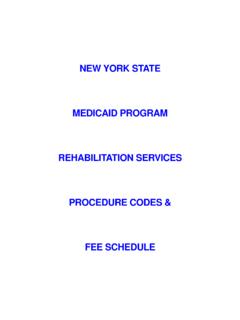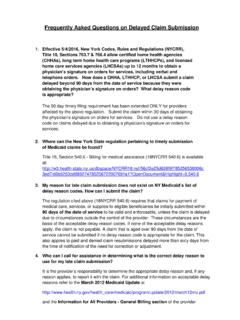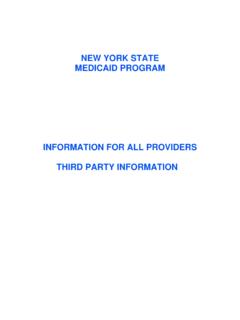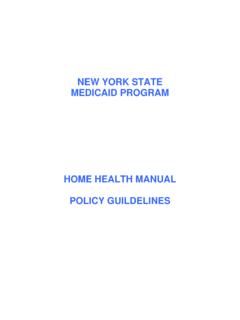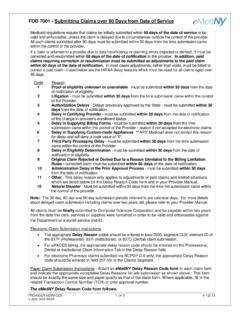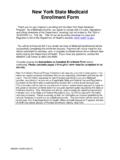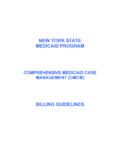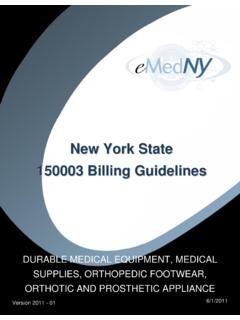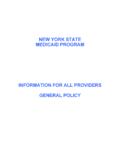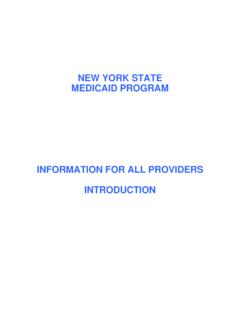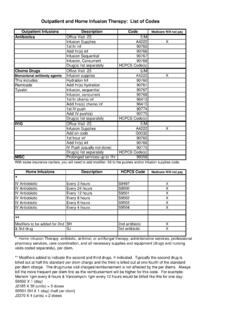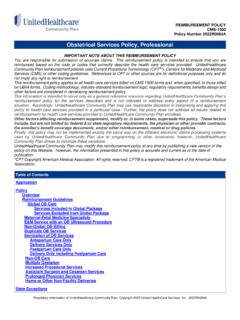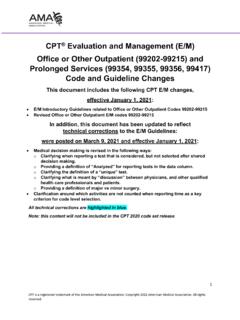Transcription of Physician Procedure Codes - eMedNY
1 NEW YORK STATE MEDICAID PROGRAM Physician Procedure Codes SECTION 2 MEDICINE, DRUGS and DRUG ADMINISTRATION Physician Procedure Codes , Section 2- Medicine, Drugs and Drug Administration Version 2019 Page 2 of 101 Table of Contents GENERAL RULES AND INFORMATION .. 3 MMIS MODIFIERS .. 13 EVALUATION AND MANAGEMENT services .. 15 LABORATORY services PERFORMED IN A Physician 'S OFFICE .. 38 DRUGS AND DRUG ADMINISTRATION .. 39 IMMUNIZATIONS .. 39 DRUGS ADMINISTERED OTHER THAN ORAL METHOD .. 43 HYDRATION, THERAPEUTIC, PROPHYLACTIC AND DIAGNOSTIC .. 53 CHEMOTHERAPY DRUGS.
2 57 MEDICINE.. 61 PSYCHIATRY .. 61 DIALYSIS .. 64 GASTROENTEROLOGY ..67 OPHTHALMOLOGY .. 68 SPECIAL OTORHINOLARYNGOLOGIC services .. 73 CARDIOVASCULAR .. 76 NONINVASIVE VASCULAR DIAGNOSTIC STUDIES .. 87 PULMONARY ..89 ALLERGY AND CLINICAL IMMUNOLOGY .. 90 NEUROLOGY AND NEUROMUSCULAR PROCEDURES .. 92 CENTRAL NERVOUS SYSTEM ASSESSMENTS/TESTS .. 97 PHOTODYNAMIC THERAPY .. 98 SPECIAL DERMATOLOGICAL PROCEDURES .. 98 OSTEOPATHIC MANIPULATIVE TREATMENT.. 99 SPECIAL services ..99 MODERATE (CONSCIOUS) SEDATION .. 100 OTHER services AND PROCEDURES .. 100 Physician Procedure Codes , Section 2- Medicine, Drugs and Drug Administration Version 2019 Page 3 of 101 GENERAL RULES AND INFORMATION 1.
3 PRIMARY CARE: Primary care is first contact care, the type furnished to individuals when they enter the health care system. Primary care is comprehensive in that it deals with a wide range of health problems, diagnosis and modes of treatment. Primary care is continuous in that an ongoing relationship is established with the primary care practitioner who monitors and provides the necessary follow-up care and is coordinated by linking patients with more varied specialized services when needed. Consultations and care provided on referral from another practitioner is not considered primary care.
4 2. CLASSIFICATION OF EVALUATION AND MANAGEMENT (E/M) services : The Federal Health Care Finance Administration has mandated that all state Medicaid programs utilize the new Evaluation and Management coding as published in the American Medical Association's Physicians' Current Procedural Terminology. For the first time, a major section has been devoted entirely to E/M services . The new Codes are more than a clarification of the old definitions; they represent a new way of classifying the work of practitioners. In particular, they involve far more clinical detail than the old visit Codes .
5 For this reason, it is important to treat the new Codes as a new system and not make a one-for-one substitution of a new code number for a code number previously used to report a level of service defined as "brief", "limited", "intermediate", etc. The E/M section is divided into broad categories such as office visits, hospital visits and consultations. Most of the categories are further divided into two or more subcategories of E/M services . For example, there are two subcategories of office visits (new patient and established patient) and there are two subcategories of hospital visits (initial and subsequent).
6 The subcategories of E/M services are further classified into levels of E/M services that are identified by specific Codes . This classification is important because the nature of practitioner work varies by type of service, place of service, and the patient's status. The basic format of the levels of E/M services is the same for most categories. First, a unique code number is listed. Second, the place and/or type of service is specified, eg, office consultation. Third, the content of the service is defined, eg, comprehensive history and comprehensive examination. (See levels of E/M services following for details on the content of E/M services .)
7 Fourth, the nature of the presenting problem(s) usually associated with a given level is described. Fifth, the time typically required to provide the service is specified. 3. DEFINITIONS OF COMMONLY USED E/M TERMS: Certain key words and phrases are used throughout the E/M section. The following definitions are intended to reduce the potential for differing interpretations and to increase the consistency of reporting. NEW AND ESTABLISHED PATIENT: Solely for the purpose of distinguishing between new and established patients, professional services are those face-to-face services rendered by a Physician and reported by a specific code .
8 A new patient is one who has not received any professional services from the practitioner or practitioners working in the same specialty within the same group within the past three years. An established patient is one who has received professional services from the practitioner within the past three years. Physician Procedure Codes , Section 2- Medicine, Drugs and Drug Administration Version 2019 Page 4 of 101 In the instance where a practitioner is on call for or covering for another practitioner, the patient's encounter will be classified as it would have been by the practitioner who is not available.
9 No distinction is made between new and established patients in the emergency department. E/M services in the emergency department category may be reported for any new or established patient who presents for treatment in the emergency department. CHIEF COMPLAINT: A concise statement describing the symptom, problem, condition, diagnosis or other factor that is the reason for the encounter, usually stated in the patient's words. CONCURRENT CARE: is the provision of similar services , eg, hospital visits, to the same patient by more than one practitioner on the same day. When concurrent care is provided, no special reporting is required.
10 Modifier -75 has been deleted. COUNSELING: Counseling is a discussion with a patient and/or family concerning one or more of the following areas: diagnostic results, impressions, and/or recommended diagnostic studies; prognosis; risks and benefits of management (treatment) options; instructions for management (treatment) and/or follow-up; importance of compliance with chosen management (treatment)options; risk factor reduction; and patient and family education. FAMILY HISTORY: A review of medical events in the patient s family that includes significant information about: the health status or cause of death of parents, siblings, and children; specific diseases related to problems identified in the Chief Complaint or History of the Present Illness, and/or System Review; diseases of family members which may be hereditary or place the patient at risk.
